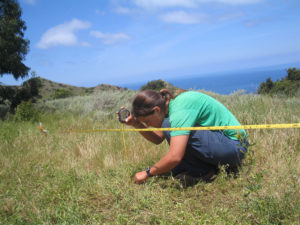Assessing Research Needs

Monitoring plants on Catalina Island. Photo by John Knapp
California needs a coordinated plan to direct research efforts on invasive plants. Cal-IPC surveyed researchers and land managers throughout the state to to produce a summary of major research needs for California invasive plants, encompassing both biological and social/policy topics.
Climate Adaptation
Serving as a link between researchers and practitioners in the natural resource community, Cal-IPC is helping managers develop new and better ways to address strategic challenges related to climate change.
The Cost of Invasive Plants in California
In order to communicate the importance of invasive plants, it is important to quantify their economic impact. This is difficult, especially for impacts to biodiversity, but the amount spent on controlling invasive plants provides one useful figure. Cal-IPC aggregates the amount spent by organizations across the state.
Weed Risk Assessment
We all know an ounce of prevention is worth a pound of cure, especially for weeds. But how can we know which new weeds to look out for? Which weeds already in California are most likely to expand into new areas? Which non-native plants might present a threat if introduced to California? Such topics are the focus of the sub-discipline of Weed Risk Assessment.
Arundo Donax: Distribution and Impacts
From 2008-2010, Cal-IPC mapped Arundo donax distribution in coastal watersheds from Monterey to San Diego, and completed an assessment of impacts including biomass production, fire, fluvual processes, and listed specied habitat. The impacts report, maps, and geodatabase are available for download.
Biological Controls
Biocontrol agents are insects or pathogens imported from an invasive plant’s home range in order to control the plant in its invasive range. These agents reduce the vigor of the invasive plant through disease, direct herbivory, or ovipositing that forms galls. Because of food web dynamics, biocontrol agents cannot eradicate an invasive plant, but can keep populations at low levels.
Invasive Plants and Wildlife
Invasive plants and wildlife interact in numerous ways. In some cases, invasive plants replace native species that wildlife depend on for food or shelter. In other situations, wildlife use and spread invasive plants.
Saharan Mustard (Brassica tournefortii)
Brassica tournefortii is a major weed in southern desert regions of California. The extent of the plant’s range was apparent in spring 2005 after steady winter rains. Cal-IPC works with partners in the region to understand more about the plant’s biology, impacts, range, and management.
